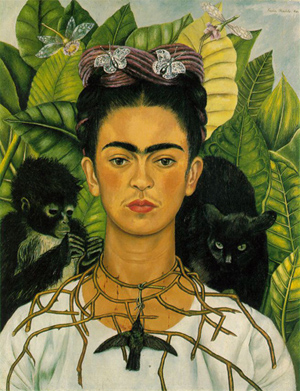
The exhibition in Rome will investigate the artist and her relationship with the cultural and artistic movements of her time, while the one in Genoa will regard the other great influence on Kahlo’s work: the one stemming from her private world, in which she experienced great physical and emotional suffering and where her husband, Diego Rivera, was the most prominent person.
The exhibition at the Scuderie del Quirinale is Italy’s first retrospective of the Mexican artist. Curated by Helga Prignitz-Poda, the author of the catalogue raisonné of the Kahlo’s works, and organized by the Azienda Speciale Palaexpo with Mondo Mostre, the exhibition will include about 170 paintings and drawings. It will cover her entire artistic career, bringing together masterpieces from the most important public and private collections in Mexico, Europe and the United States.
More than 40 extraordinary portraits and self-portraits, including the famous 1940 Self-portrait with Thorn Necklace and Hummingbird – on display for the first time in Italy and the image of the exhibition – and the 1926 Self-portrait in a Velvet Dress, in which her elongated neck harks back to the aesthetics of Parmigianino and Modigliani. Her first self-portrait, the latter was painted when she was only 19 years old for her beloved Alejandro GòmezArias with the intention of winning him back.
The exhibition will also display a selection of drawings, including the 1932 pencil sketch for the painting Henry Ford Hospital (The Flying Bed); the famous plaster corset that imprisoned Kahlo right after the accident, which she painted before moving on to her portraits – a unique object until recently thought to be lost; and, finally, several exceptional photographic portraits of the artist, in particular those by Nickolas Muray, her lover for 10 years, including Frida on a White Bench, New York, 1939, which became a famous cover of Vogue magazine.
It is not possible to understand Kahlo’s works without knowing about her life. Magdalena Carmen Frida Kahlo y Calderón said that she was born on July 6, 1907 in Coyoacán, then a small town on the outskirts of Mexico City. She liked to consider herself a daughter of the Mexican Revolution, which began in 1910 and ended in 1917: “I was born with a revolution. Let’s say so. It’s in that fire that I was born, carried by the impetus of the revolt until the moment I saw the light of day. The day was scorching. It inflamed me for the rest of my life. I was born in 1910. It was summer. Shortly after, Emiliano Zapata, el Gran Insurrecto, was to rouse the South. I had this good luck: 1910 is my date.”
There is no doubt that by now the legend created around the figure of Frida Kahlo (1907-1954) has attained global proportions: an indisputable icon of 20th-century Mexican culture, a revered forerunner of the feminist movement, a cult brand of world-wide merchandising, the seductive subject of a Hollywood movie, and the first Hispanic woman portrayed on a United States postage stamp, Kahlo lends herself to contemporary culture through one of the most fascinating inextricable relationships between art and life in the entire 20th century.
Her paintings are not only the reflection of her biographical vicissitudes, which were marked by the physical and psychological damage inflicted by the terrible accident in which she was involved when she was 17 years old. Her art is fused with the history and the spirit of the world of her time, reflecting the social and cultural transformations that led to the Mexican Revolution and ensued from it. The revolutionary spirit drove her to reinterpret the native past and the traditions of its folklore, identity codes that generated an unprecedented fusion between self-expression, and the language, the imagination, and the colors and symbols of Mexican popular culture. At the same time, Kahlo is an expression of the artistic avant-garde and the cultural exuberance of her time, and study of her work enables us to understand the interweaving of the trajectories of all the international cultural movements that passed through Mexico at that time: from revolutionary Pauperism and Stridentism to Surrealism and what years later came to be called Magical Realism.
And yet her most important theme is self-portrayal, which Kahlo develops using the dominant artistic languages of the different periods in a process in which she forgets all sources. The numerical weight of the “self-portrait” genre in the artist’s total production conveys the very special significance that it has represented in transmitting the iconographic, psychological and cultural values inherent in the “Frida legend.”
The exhibition will display and investigate Frida Kahlo’s artistic production in its evolution from its beginnings under the influence of the New Objectivity and Magical Realism and her reinterpretation of ancestral and traditional native art to the reflections of the American Realism of the 1920s and ’30s and the ideological and political components modeled on Mexican Muralism, as well as account for such influences. Thus, by walking through a single and rare exhibition, it will be possible to admire Kahlo’s works next to a selection of works by the artists active in that period who “lived” physically and artistically near her, from her husband, Rivera – who will be present with several significant works, such as Portrait of Natasha Gelman from 1943, Nude (Frida Kahlo) from 1930, and Self-portrait from 1948 – to others such as José Clemente Orozco, José David Alfaro Siqueiros and Maria Izquierdo.

